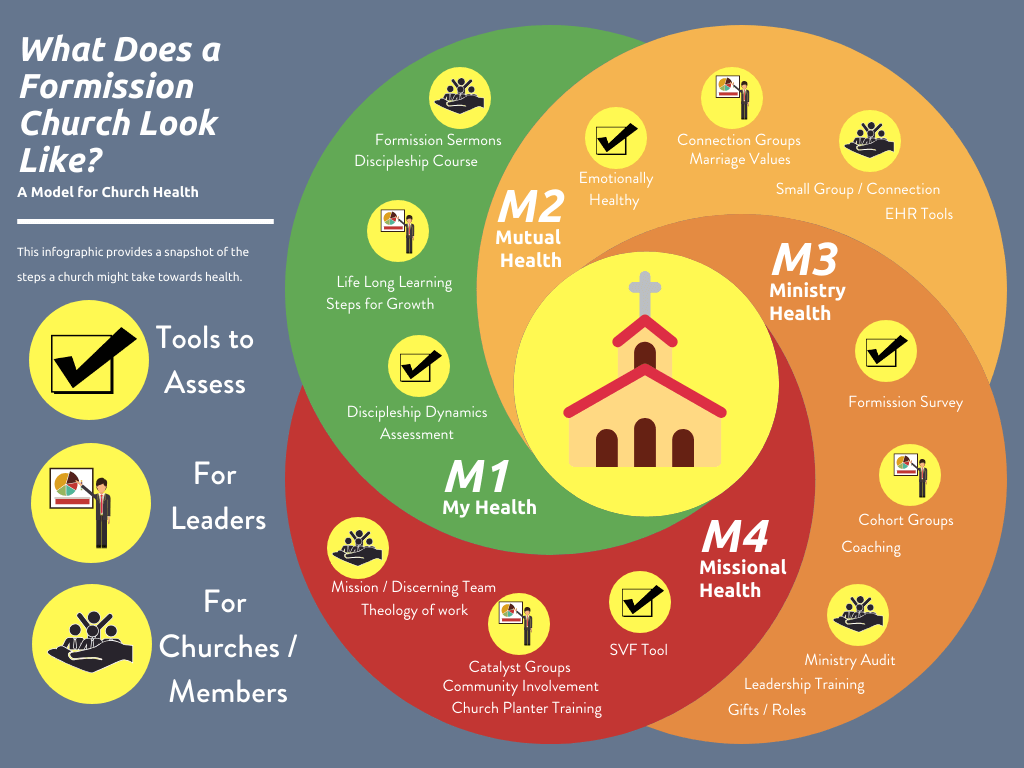While Formission.org is updating, we will be hosting a few Formission blog posts here on paonl.ca. We hope you enjoy the content, and encourage you to download the Formission app on the app store or google play for more great resources.
What does a Formission church look like? In rabbinical fashion, I’ll answer a question with a question: What does McDonalds look like? It has the universally known symbol. Its menu is consistent but adapted to its context. It appeals to families and is cross-generational. Culture and staff behaviour are consistent with company values. It is full of people at any given time. People buy there because the product has a universal appeal.
The analogy is FAR from perfect. For example, every Formission church should be about promoting health (physical, mental, spiritual). When we think McDonalds, we probably aren’t picturing all the health benefits. But Formission is something like good franchising in that it aims for a consistency of values and experience across a broad network of locations. It is a philosophy and methodology that should translate to predictable, practical, visible outcomes.
Our goal is certainly not to have every PAONL member wearing Formission t-shirts, or humming some version of the “I’m loving it” jingle to Formission catch-phrases. It wouldn’t bother us in the least if a church left out the word and logo altogether and just lived out the values.
So, what are Formission values? A good synopsis is found in 1 Peter chapter 2, where the apostle uses four metaphors to describe the church and highlight its purpose:
Newborn Babies (My Health – vv.1-3))
A Formission church is on a path to maturity. Whenever you hear the pastors or leaders speak, they are sharing about how God is transforming their own physical, mental, and spiritual health. They are always communicating about growth and allowing others to tell stories about how God is transforming their lives. It is an unhurried church, where there is space and time for encounter and listening, where the Spirit makes the word come alive to hearts, and believers are taught to self-feed and equipped to live in the counter-cultural rhythms of grace.
Living Stones (Mutual Health – vv.4-8)
A Formission church is about the people, not the building. It takes seriously Peter’s words that we are actually being built into a spiritual house: little living temples. And the temples are not neglected. Marriages are prioritized. Reconciliation is practiced. Families are valued. You will likely see youth and elders serving together and worshiping together, eating from the same tables and talking in the same circles. Their worship war is trying to out-love and out-serve each other. You will see intentional discipleship. You will see those with nothing else in common united by having the most important thing in common.
A Royal Priesthood (Ministry Health – v.9)
In Formission churches, you won’t see the paid clergy doing most of the ministry. She will instead be equipping the saints for the work of the ministry. The saints, meanwhile, will be fulfilling their calling to be a kingdom of priests and always discovering new gifts of grace to practice. They will be carriers of good news, feeders of widows and orphans, visitors of the sick and imprisoned. The pastor-teacher (Ephesians 4:11-12) will model these things always with an eye on training others to do the same, celebrating and developing the giftings of others.
The People of God (Missional Health – v.10)
Finally, you will notice that Formission churches point outwards. In the foyer they are always looking for someone to welcome into their circle – they face outwardly. When they pray together, their prayer lists are populated with the needs of the community. Their hands stretch towards the outer walls. They tend to see their everyday work of fixing cars and raising kids and sweeping floors, practicing hospitality and answering phones as the work of God. Every Sunday involves a sending. Grace is freely received to be freely given. They are the people of God living and announcing life in the kingdom in anticipation of the immanent return of Christ.
Summary
A Formission church is not one that has necessarily attained all of this. It is one that has committed to the process of living out these values through the power of the Holy Spirit.
I have seen pictures of this in every church I have visited across Newfoundland. After all, if your mission involves the Great Commandment (Formation) and the Great Commission, you are already spelling Formission. If not, I’m not sure you qualify properly as a church (cue nervous laughter). I see pastors celebrating recovery, taking up running, being life-long learners, taking rest seriously. That is Formission. I see churches doing 1/5/10 year plans, looking at ministry inter-generationally, doing (or being intentionally) a small group, trying Alpha, equipping parents, discerning where God is at work in their communities. That is also Formission.
If you want to be a part of a Formission church, a great starting point is to do the next right thing for your own discipleship. You can find a host of resources on the Formission app: videos, blog posts, Bible reading plans, curriculum options, health checkups. A great next step would be planning a Formission Sunday or getting involved in initiatives like the Formission ADVENTure. I would love to come speak to your church or leadership team free of charge, or just to connect and have a conversation. Here’s a great starting question:
What does a Formission church look like to you?







